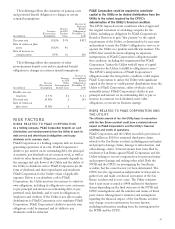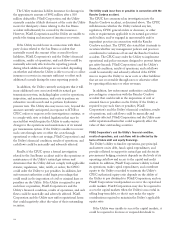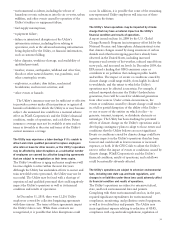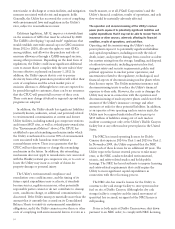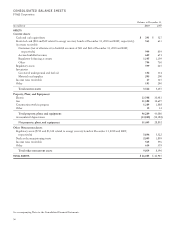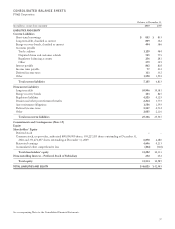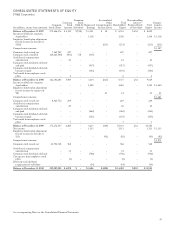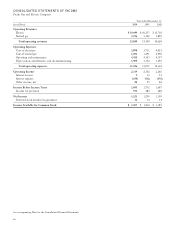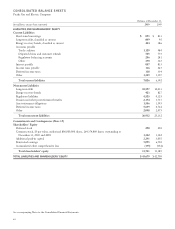PG&E 2010 Annual Report Download - page 57
Download and view the complete annual report
Please find page 57 of the 2010 PG&E annual report below. You can navigate through the pages in the report by either clicking on the pages listed below, or by using the keyword search tool below to find specific information within the annual report.safety, or security requirements; or due to other safety or
operational issues, the Utility’s operating and maintenance
costs would increase. Further, such events may cause the
Utility to be in a short position and the Utility would need
to purchase electricity from more expensive sources. In
addition, the Utility’s nuclear power operations are subject
to the availability of adequate nuclear fuel supplies on
terms that the CPUC will find reasonable.
Furthermore, certain aspects of the Utility’s nuclear
operations are subject to other federal, state, and local
regulatory requirements that are overseen by other federal,
state, or local agencies. For example, as discussed above
under “Environmental Matters,” there is substantial
uncertainty concerning the final form of federal and state
regulations to implement Section 316(b) of the Clean
Water Act. Depending on the nature of the final
regulations that may ultimately be adopted by the EPA,the
Water Board, or the California Legislature, the Utility may
incur significant capital expense to comply with the final
regulations, which the Utility would seek to recover
through rates. If either the federal or state final regulations
require the installation of cooling towers at Diablo
Canyon, and if installation of such cooling towers is not
technically or economically feasible, the Utility may be
forced to cease operations at Diablo Canyon.
If the CPUC prohibits the Utility from recovering a
material amount of its capital expenditures, nuclear fuel
costs, operating and maintenance costs, or additional
procurement costs due to a determination that the costs
were not reasonably or prudently incurred, PG&E
Corporation’s and the Utility’s financial condition, results
of operations, and cash flow would be materially adversely
affected.
The Utility is subject to penalties forfailure to comply with
federal, state, orlocal statutes andregulations. Changes inthe
political andregulatoryenvironment could cause federal and
state statutes, regulations, rules, andorders to become more
stringentand difficult to comply with, andrequired permits,
authorizations, and licenses may be more difficult to obtain,
increasing the Utility’s expenses ormakingitmore difficult for
the Utility to execute its business strategy.
The Utility must comply in good faith with all applicable
statutes, regulations, rules, tariffs, and orders of the CPUC,
the FERC, the NRC, and other regulatory agencies relating
to the aspects of its electricity and natural gas utility
operations that fall within the jurisdictional authority of
such agencies. These include customer billing, customer
service, affiliate transactions, vegetation management,
operating and maintenance practices, and safety and
inspection practices. The Utility is subject to fines,
penalties, and sanctions for failure to comply with
applicable statutes, regulations, rules, tariffs, and orders. In
particular, the CPUC may impose penalties on the Utility
if the CPUC finds that the Utility violated any law,
regulation, CPUC general orders or decisions, or other
rules or requirements applicable to its natural gas service
and facilities. The CPUC has authority to impose penalties
of up to $20,000 per day, per violation. (See “Pending
Investigations” above.)
Under the Energy Policy Act of 2005, the FERC can
impose penalties (up to $1 million per day per violation)
for failure to comply with mandatory electric reliability
standards, including standards to protect the nation’s bulk
power system against potential disruptions from cyber and
physical security breaches. As part of the continuing
development of new and modified reliability standards, the
FERC has approved changes to its Critical Infrastructure
Protection reliability standards (effective April 1, 2010) that
will establish a compliance schedule for assets that a utility
has identified as “critical cyber assets.” As these and other
standards and rules evolve, and as the wholesale electricity
markets become more complex, the Utility’s risk of
noncompliance may increase.
In addition, there is risk that these statutes, regulations,
rules, tariffs, and orders may become more stringent and
difficult to comply with in the future, or that their
interpretation and application may change over time, and
that the Utility will be determined to have not complied
with such new interpretations. If this occurs, the Utility
could be exposed to increased costs to comply with the
more stringent requirements or new interpretations and to
potential liability for customer refunds, penalties, or other
amounts. If it is determined that the Utility did not comply
with applicable statutes, regulations, rules, tariffs, or orders,
and the Utility is ordered to pay a material amount in
customer refunds, penalties, or other amounts, PG&E
Corporation’s and the Utility’s financial condition, results
of operations, and cash flow would be materially adversely
affected.
The Utility also must comply with the terms of various
permits, authorizations, and licenses. These permits,
authorizations, and licenses may be revoked or modified by
the agencies that granted them if facts develop that differ
significantly from the facts assumed when they were issued.
In addition, discharge permits and other approvals and
licenses often have a term that is less than the expected life
of the associated facility. Licenses and permits may require
periodic renewal, which may result in additional
requirements being imposed by the granting agency. In
connection with a license renewal, the FERC may impose
new license conditions that could, among other things,
53


